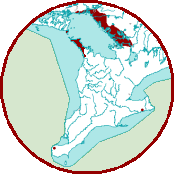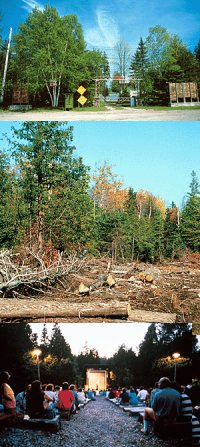
 The Bruce Peninsula encompasses a diverse array of habitats,
including exposed limestone bedrock, vertical cliffs (as part of the Niagara
escarpment), wetlands, mixed forest, fens, dunes, and open alvars. With
such a range of habitats, it is no surprise that this region is home to many
species, including the massasauga rattlesnake. This habitat diversity
also attracts visitors who seek wilderness escapes and picturesque vacations
in the same parks and reserves which provide habitat for wildlife, including
the eastern massasauga rattlesnake.
The Bruce Peninsula encompasses a diverse array of habitats,
including exposed limestone bedrock, vertical cliffs (as part of the Niagara
escarpment), wetlands, mixed forest, fens, dunes, and open alvars. With
such a range of habitats, it is no surprise that this region is home to many
species, including the massasauga rattlesnake. This habitat diversity
also attracts visitors who seek wilderness escapes and picturesque vacations
in the same parks and reserves which provide habitat for wildlife, including
the eastern massasauga rattlesnake.
Geographically, the Bruce Peninsula is a relatively
narrow section of land separating Georgian Bay from the rest of Lake
Huron. An ever-increasing demand for homes and
 cottages has contributed greatly to habitat destruction.
Increasing numbers of roads fragment what's left. And while rare plants
and animals have some habitat protection in parks and nature reserves, many
species also need to move across landscapes, which can be deadly.
cottages has contributed greatly to habitat destruction.
Increasing numbers of roads fragment what's left. And while rare plants
and animals have some habitat protection in parks and nature reserves, many
species also need to move across landscapes, which can be deadly.
Human persecution of snakes has furthered the decline
of the massasauga and other snake species in Ontario. Fear of snakes
comes from misunderstanding. Killing snakes is not only illegal, it
also perpetuates the false image of "evil" snakes. To combat this,
national and provincial parks in the Bruce Peninsula region conduct workshops
and interpretive programs that increase public awareness and help protect
and conserve rare species. As people come in increasing contact with
wildlife, education is one of the few things that can help save our native
wildlife.

Some rattlesnakes have been implanted with radio transmitters (left),
which lets biologists track them to see which habitats they prefer. |
Within the regional population of massasauga rattlesnakes
in the Bruce Peninsula, several sub-groups exist which are essentially isolated
from each other by natural and human boundaries. Because small populations
experience a higher risk of extinction, ongoing research into the ecology
and biology of the massasauga is being used by scientists to better understand
the management needs of this species.



© Brent Huffman, Toronto Zoo
2005

 The Bruce Peninsula encompasses a diverse array of habitats,
including exposed limestone bedrock, vertical cliffs (as part of the Niagara
escarpment), wetlands, mixed forest, fens, dunes, and open alvars. With
such a range of habitats, it is no surprise that this region is home to many
species, including the massasauga rattlesnake. This habitat diversity
also attracts visitors who seek wilderness escapes and picturesque vacations
in the same parks and reserves which provide habitat for wildlife, including
the eastern massasauga rattlesnake.
The Bruce Peninsula encompasses a diverse array of habitats,
including exposed limestone bedrock, vertical cliffs (as part of the Niagara
escarpment), wetlands, mixed forest, fens, dunes, and open alvars. With
such a range of habitats, it is no surprise that this region is home to many
species, including the massasauga rattlesnake. This habitat diversity
also attracts visitors who seek wilderness escapes and picturesque vacations
in the same parks and reserves which provide habitat for wildlife, including
the eastern massasauga rattlesnake.
 cottages has contributed greatly to habitat destruction.
Increasing numbers of roads fragment what's left. And while rare plants
and animals have some habitat protection in parks and nature reserves, many
species also need to move across landscapes, which can be deadly.
cottages has contributed greatly to habitat destruction.
Increasing numbers of roads fragment what's left. And while rare plants
and animals have some habitat protection in parks and nature reserves, many
species also need to move across landscapes, which can be deadly.